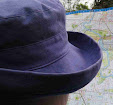 |
| Three mates out rabbiting, 1920s. Courtesy of Louise Hill-Coleman. |
Louise Hill-Coleman had this photo in her family collection, but knew little about it other than recognising her grandfather
Thomas Hill in the centre, out rabbiting with mates.
Louise had contacted me some while back about her grandfather
Thomas Hill and his son
Arthur, who had been killed in France, an underage soldier. She kindly provided photographs and papers relating to Thomas and Arthur for the website. A previous post about Arthur can be seen
here.
Earlier this year I was likewise contacted by Matt Freckleton, whose grandfather
Eric Herman had also served in the Great War. Previous blog postings about Eric can be seen
here and
here.
Both Thomas Hill and Eric Herman, and Eric's brother Joseph, had ended up in 4th Division Headquarters in France. Matt had unearthed the AWM
photo of the 4th Div HQ, which he sent me to illustrate his story of his grandfather's war service. The soldiers in this photo had been named, and when I had a look at it (just in case I knew any other local men in the photo), I recognised the name of
Thomas Hill. I also noted that both
Thomas Hill and
Joseph Herman (also in the 4th Div HQ photo) had been employed as tobacco workers before the war, which suggested they might have known each other before the war. They were the same age and had enlisted on the same day. It was possible. I put Louise and Matt in touch with one another, and they have since enjoyed corresponding about their respective grandfathers, and doing further research.
Louise, painstakingly working through their B2455s, went on to discover that Joseph Herman and Thomas Hill had been charged on the same day with the same offence - and Matt had a possible explanation! You can read about that in the story he wrote about his grandfather
Eric Herman.
Louise, having seen the photo of Eric, had a sudden brainstorm and burrowed into her grandfather's photos to find the one above - which shows three mates out enjoying a rabbiting expedition in the 1920s. She now knows them as probably
Joseph Herman on the left,
Thomas Hill in the middle, and
Eric Herman on the right. Matt's mother thought the man on the left looked like Joseph.
This story illustrates the value of sharing family stories and photos, as the piecing together of the story of Thomas Hill and the Herman brothers, and the understanding of who was in the photo to which Louise had not attached a particular meaning, could only have happened with a willingness to share. More than just unknown mates, the three men had a shared history in the Great War.





















